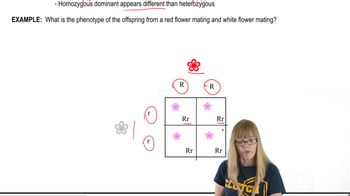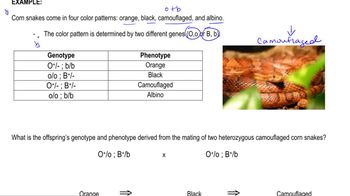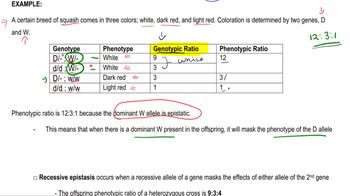Table of contents
- 1. Introduction to Genetics51m
- 2. Mendel's Laws of Inheritance3h 37m
- 3. Extensions to Mendelian Inheritance2h 41m
- 4. Genetic Mapping and Linkage2h 28m
- 5. Genetics of Bacteria and Viruses1h 21m
- 6. Chromosomal Variation1h 48m
- 7. DNA and Chromosome Structure56m
- 8. DNA Replication1h 10m
- 9. Mitosis and Meiosis1h 34m
- 10. Transcription1h 0m
- 11. Translation58m
- 12. Gene Regulation in Prokaryotes1h 19m
- 13. Gene Regulation in Eukaryotes44m
- 14. Genetic Control of Development44m
- 15. Genomes and Genomics1h 50m
- 16. Transposable Elements47m
- 17. Mutation, Repair, and Recombination1h 6m
- 18. Molecular Genetic Tools19m
- 19. Cancer Genetics29m
- 20. Quantitative Genetics1h 26m
- 21. Population Genetics50m
- 22. Evolutionary Genetics29m
3. Extensions to Mendelian Inheritance
Epistasis and Complementation
Problem 24c
Textbook Question
Blue flower color is produced in a species of morning glories when dominant alleles are present at two gene loci, A and B. (Plants with the genotype have blue flowers.) Purple flowers result when a dominant allele is present at only one of the two gene loci, A or B. (Plants with the genotypes and are purple.) Flowers are red when the plant is homozygous recessive for each gene (i.e., aabb).
If an F₁ plant is backcrossed to one of the pure-breeding parental plants, what is the expected ratio of phenotypes among progeny? Why is the phenotype ratio the same regardless of which parental strain is selected for the backcross?
 Verified step by step guidance
Verified step by step guidance1
span>Identify the genotypes of the F₁ plant and the pure-breeding parental plants. The F₁ plant is typically heterozygous at both loci (AaBb), while the pure-breeding parental plants are either AABB, AAbb, aaBB, or aabb.</span
span>Determine the possible gametes produced by the F₁ plant (AaBb). The F₁ plant can produce four types of gametes: AB, Ab, aB, and ab.</span
span>Consider the backcross scenarios: (1) F₁ plant backcrossed with AABB, (2) F₁ plant backcrossed with AAbb, (3) F₁ plant backcrossed with aaBB, and (4) F₁ plant backcrossed with aabb.</span
span>For each backcross scenario, perform a Punnett square analysis to determine the genotypes and corresponding phenotypes of the progeny. Remember that blue flowers require at least one dominant allele at both loci, purple flowers require a dominant allele at one locus, and red flowers require recessive alleles at both loci.</span
span>Analyze why the phenotype ratio is the same regardless of which parental strain is selected for the backcross. Consider the dominance relationships and how they affect the expression of flower color in the progeny.</span
Recommended similar problem, with video answer:
 Verified Solution
Verified SolutionThis video solution was recommended by our tutors as helpful for the problem above
Video duration:
6mPlay a video:
Was this helpful?
Key Concepts
Here are the essential concepts you must grasp in order to answer the question correctly.
Dominant and Recessive Alleles
In genetics, alleles are different forms of a gene that can exist at a specific locus. Dominant alleles mask the expression of recessive alleles in heterozygous conditions. In the context of the morning glories, the presence of dominant alleles at loci A and B results in blue flowers, while the absence of these dominant alleles leads to purple or red flowers, depending on the genotype.
Recommended video:
Guided course

Variations on Dominance
Gene Interaction
Gene interaction occurs when two or more genes influence a single trait, leading to a variety of phenotypes. In this case, the interaction between the two loci (A and B) determines the flower color in morning glories. The presence of dominant alleles at both loci results in blue flowers, while the presence of a dominant allele at only one locus results in purple flowers, illustrating how multiple genes can affect a single phenotype.
Recommended video:
Guided course

Interacting Genes Overview
Backcrossing and Phenotypic Ratios
Backcrossing involves crossing an F₁ hybrid with one of its parental strains to analyze the inheritance patterns of traits. The expected phenotypic ratio among progeny from this backcross remains consistent regardless of which parental strain is used because the genetic contributions from the F₁ hybrid and the pure-breeding parent are the same, leading to predictable ratios based on Mendelian inheritance principles.
Recommended video:
Guided course

Mutations and Phenotypes

 5:05m
5:05mWatch next
Master Complementation with a bite sized video explanation from Kylia Goodner
Start learning




